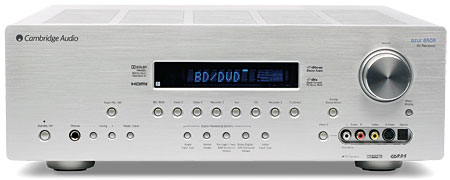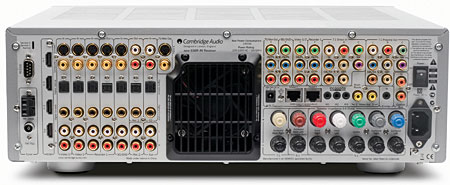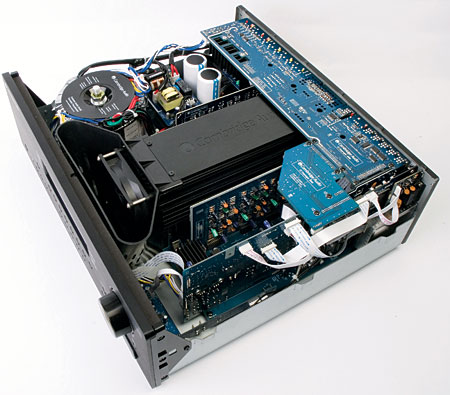Cambridge Audio Azur 650R A/V Receiver
Simpler Sounds Better

I’m not sure I qualify as an Anglophile, but I do like most things British—except for spotted dick. Even after you know that it’s just steamed suet pudding, it still doesn’t sound any better. So I expected that I’d feel a continually growing affinity for the new Azur 650R AVR from Cambridge Audio (that’s the “other” Cambridge for you Massachusetters). Since it began in 1968, the company has made a well-respected, high-fidelity name for itself. It even built the world’s first two-box CD player. After a tough time in the mid-’80s, Cambridge Audio was acquired by Audio Partnership, which currently owns a number of other venerable U.K. brands. As I hear them tell it, this economy of scale is a good thing for Cambridge Audio—and something that most higher-end companies don’t normally enjoy—because such a spread of brands lets the parent company employ an unusually high percentage of engineers on their staff (almost 40 percent). They happily tell the fact as if it guarantees them success and good cheer. Or at least good gear. I certainly expected it to be that way. I was initially impressed by the specs and build quality, so it surprised me when I didn’t keep that warm and fuzzy-logic feeling after I first set up the Azur 650R. In fact, I began to think that maybe Audio Partnership had hired too many engineers.
As I’ve experienced once or twice in my life, sometimes it’s the second impression that can be deceiving. I learned that lesson again with the Azur 650R. But before I get into what made me temporarily lose my faith in our cousins across the ocean, let’s go over what will initially excite you. Befitting its high-fidelity heritage, the Azur 650R has the impressive Cirrus CS49700 audio-processing chipset with twin 32-bit DSP cores. In other words, it has serious processing power. It supports just about every audio codec known to man, including Dolby TrueHD and DTS-HD Master Audio. It has a ginormous low-flux toroidal transformer, which helps it drive seven channels simultaneously at a specified 100 watts. (Two-channel mode is specified at 120 watts per channel.) It’s also one of the reasons why Cambridge Audio claims that the Azur 650R sounds like separates rather than an AVR—and why it also claims that it can handle virtually any impedance load.

A cool biamping mode lets you use the built-in surround back right and surround back left amplifiers in conjunction with the front left and right amplifiers to biamp the front main speakers in a 5.1-channel system. Some AVRs let you use those extra channels for a second zone, but the Azur 650R includes outputs for two more rooms of audio using amplified A-BUS keypads (plus composite video, if you run the extra cable) instead. I think that was a brilliant design choice.
Batteries Shouldn’t Have Been Included
Physically, the Azur 650R is a low-key beauty with an appropriate assortment of buttons. It sports a front-panel auxiliary composite/S-video input plus a nicely done wraparound aluminum (or, as they say over there, aluminium) case and solid chassis. So far, so good; but here’s where my temporary disillusionment began. The remote control reminds me of a plate of fish and chips—passable if you’re really hungry but not a first choice for fine cuisine. The Azur 650R’s remote is laid out with narrow rows of small, round buttons. They’re silk-screened with lettering that’s hard to read even before your thumb wears it off. The remote itself feels solid and well-built, but the centrally located thumb pad feels like an afterthought that was stuck on with a piece of double-stick tape before it left the factory. Either the British have much smaller and more nimble thumbs than I do, or they should go back to their supplier and beat them over the head with one of these remotes. This is more than a nitpick. You need the thumb pad to navigate the AVR’s basic menu system, and there’s no way to access the menu from the Azur 650R’s front panel. More than once when I thought I was pushing the Down section of the pad, the remote thought I was pushing the Right side. I suppose most people who buy an $1,800 AVR will have a universal remote control, so this definitely isn’t a deal-breaker. It’s highly annoying, though. In an extremely helpful gesture, Cambridge Audio offers all of the unit’s discrete remote control codes on its Website. Programming-savvy installers and programming-familiar consumers can download the codes into their Pronto, Nevo, URC, or (insert brand here) remote control.

The Azur 650R’s menu system is also annoying. It’s basic—really basic. When I paged through the menus during the setup, it felt a bit like I was working with an old Commodore 64. (Yeah, I’m that old.) I’m exaggerating here, but seriously, the font and layout looked like they were designed in the late 1980s just before the designer retired. Cambridge Audio must still be looking for his replacement.
Simple Is as Simple Does
Every company has a reason for existence coded in its DNA. Some are quite eager to make as much money as possible. Others have a nobler intent (although they still need to make money to stay in business). It’s obvious from the company’s marketing, pricing, and design goals that Cambridge Audio isn’t out to sell gear to the unwashed masses. I don’t think we’ll see a Cambridge Audio HTIB anytime soon. Simplicity and purity are what the company is after. Depending on the type of person you are, this is either a good thing or something that will leave you less than thrilled.





























































